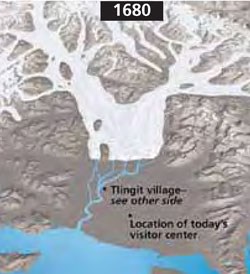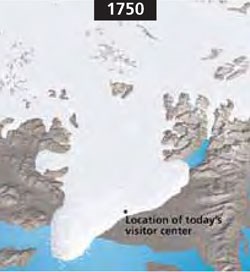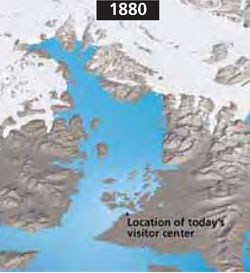
Glaciers Advance, Glaciers RetreatUntil 10,000 years ago, continental-scale ice sheets came and went many times for seven million years. During this Great Ice Age these ice sheets would reach as far south as the upper Midwest of the United States. Glacier Bay today is the product of the Little Ice Age, a geologically recent glacial advance in northern regions. The Little Ice Age reached its maximum extent around 1750. Since then, the massive glacier that filled the bay has retreated 65 miles to the heads of its inlets. Today, 95% of Alaska's 100,000 glaciers are currently thinning, stagnating, or retreating, and more importantly, the rate of thinning is increasing. Glacier Bay's glaciers follow this trend. Recent research determined that there is 11% less glacial ice in Glacier Bay than in the 1950s. However, heavy snowfall in the towering Fairweather Mountains means that Glacier Bay remains home to a few stable glaciers, a rarity in today's world. 
1680At Glacier Bay you can witness geologic processes and change usually barely noticed in the span of a human life. In 1680, there was no Glacier Bay, only a broad valley with a glacier moving down it. Abundant geologic information and Lingít cultural memories describe a large valley in the lower Bay, environmentally harsh but habitable. Huna Lingít villages bordered two named rivers flowing near present-day Rush Point and Bartlett Cove. Huna Lingít place names speak eloquently of the bay and even reflect the landscape changes that occurred as the glacier advanced and later retreated.
1750The Little Ice Age came and went quickly by geologic measures. By 1750 the glacier reached its maximum, overwhelming the Lingít living there and extending a snout into Icy Strait almost to Lemesurier Island. It was able to hold this position only briefly before succumbing to marine erosion and beginning the dramatic retreat for which Glacier Bay has become world famous. When Captain George Vancouver sailed here 45 years later, the glacier had receded five miles back into Glacier Bay.
1880When conservationist John Muir traveled here in search of active glaciers in 1879, the glacier he sought had retreated 40 more miles up the bay since Vancouver's visit. A renowned author, Muir captured the popular imagination about Alaska, attracting tourists (and researchers) to Glacier Bay. Like most people today, they arrived by ship. 
TodayToday you must travel 65 miles up the bay to view tidewater glaciers - a far cry from the glacier's 1750 maximum. The large glacier that once filled the bay has divided into its smaller tributaries and in all but a few special cases, retreated from salt water. Although spectacular, remember that today's glaciers are mere remnants of what once was. Will they advance again, or will Glacier Bay someday be all bay and no glacier? Polar regions respond to changes in climate at faster rates than temperate and equatorial regions do. How will Glacier Bay change in your lifetime? |
Last updated: September 26, 2025
